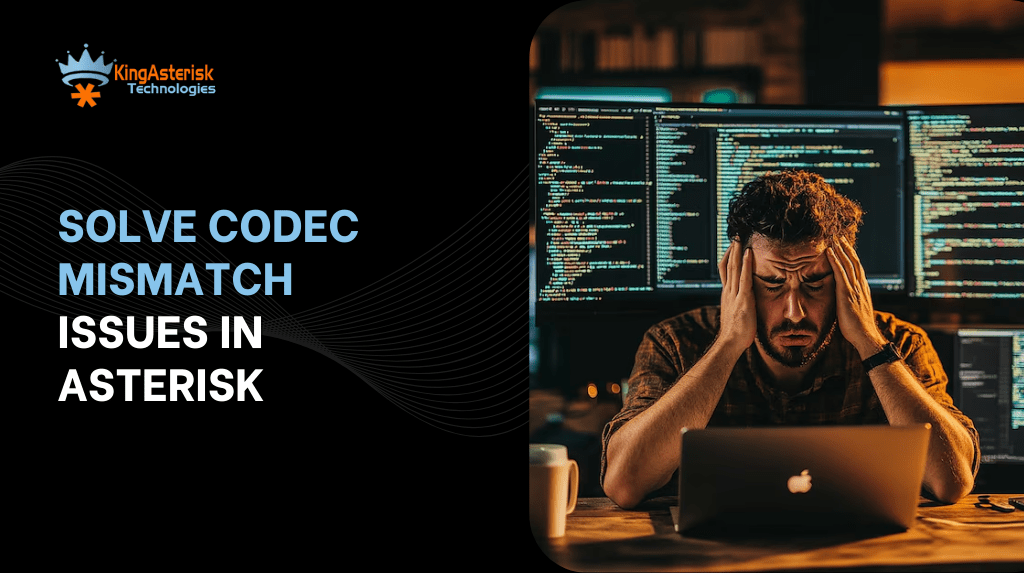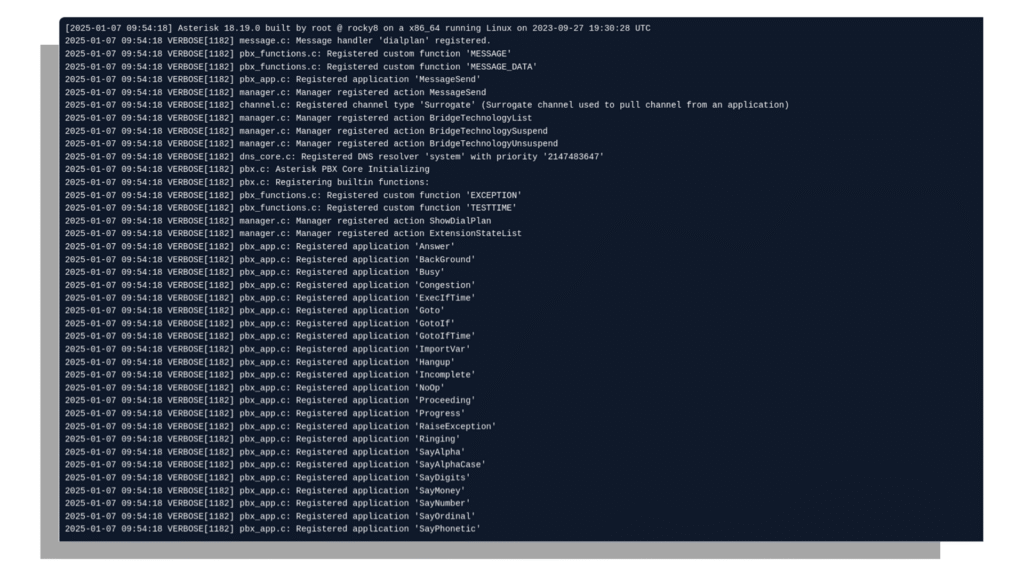
Maybe the customer hears you just fine, but all you get is dead silence? This isn’t a ghost in the machine; it’s the classic sign of an Asterisk Codec Mismatch Fix waiting to happen. For any business running a contact center solution, especially one built on a powerful, open-source platform like Asterisk Development, this is more than just a minor inconvenience—it’s a business-critical issue that can ruin customer trust and cost you money. In the world of VoIP, a codec is a small, but mighty piece of code.
As a leading VoIP development company, we’ve seen it all, from a simple Asterisk one-way audio issue to complex call-quality mysteries. The good news? These problems are almost always fixable. This guide will walk you through everything you need to know to become a troubleshooting pro, so you can get your calls flowing smoothly and reliably.
Asterisk Codec Mismatch and Why It’s a Call Center’s Worst Nightmare?
The result is often the dreaded Asterisk no audio on calls. You might experience a variety of symptoms. One-way audio is the most common. These issues go way beyond technical headaches. For a call center, they mean lost leads, poor customer experience, and wasted agent time. Imagine a sales call where the prospect hangs up because they think the line is dead. That’s a direct hit to your bottom line.

At KingAsterisk Technology, we see businesses in places like Phoenix, Arizona, facing these exact challenges, and they often don’t realize that a simple VoIP codec troubleshooting session is all they need.
The Two Big Players: G.711 vs G.729 Asterisk
Before we fix this, let’s discuss two common codecs: G.711 and G.729.
G.711 (The Universal Language)
This is the gold standard for VoIP. It’s uncompressed, offers fantastic call quality, and uses a lot of bandwidth (about 87 kbps per call). It’s the perfect choice for most modern offices with a reliable, high-speed internet connection. Since it’s uncompressed, it also requires minimal CPU power from your Asterisk server.
G.729 (The Efficient One)
The catch? The trick to a permanent Asterisk Codec Mismatch Fix is making sure both ends of the call agree on one of these (or other) codecs.
Popular Article: Expert Vicidial Skin Development Services
Diagnosing the Problem: Your Asterisk Codec Troubleshooting Guide
The key to solving any Asterisk call troubleshooting guide is knowing where to look. Your Asterisk Command Line Interface (CLI) is your best friend here.
Step 1: Tracing One-Way Audio Asterisk with the CLI
The very first thing you need to do is get a snapshot of an active call that’s having trouble.
For PJSIP (The newer, better way):
Look at the output. You’ll see a line for each channel. Pay close attention to the Codecs and RTP columns. If you see G.711 on one side and G.729 on the other, you’ve found your culprit.
For SIP (The older, more traditional way):
Similar to PJSIP, check the Codecs column. Do they match? If not, you’re looking at a classic Asterisk SIP trunk configuration problem.
Step 2: The Deep Dive: Asterisk Debug Codec Negotiation
This is where you go from a detective to a forensic scientist. You need to watch the conversation between the two phones in real-time.
- Turn on the PJSIP logger
- Make a test call.
- Watch the CLI output closely.
- Find the m=audio line
- Compare the Offer and Answer.
In our experience serving the greater Chicago area, about 70% of all VoIP call quality issues we see are directly tied to an improperly configured codec negotiation. We’ve found that a little time spent in the CLI can save hours of frustration.
A Step-by-Step Guide for an Asterisk Codec Mismatch Fix
Once you’ve diagnosed the problem, it’s time for the solution. There are two primary ways to approach a permanent Asterisk Codec Mismatch Fix: codec prioritization and transcoding.
Solution 1: PJSIP Codec Priority Configuration
This line defines which codecs are allowed. You need to set them in a specific order. Asterisk will try the codecs from left to right. If that fails, try G.711 a-law. If that also fails, try G.729, and so on.” This is how you solve Asterisk codec problems for good.
We’ve used this exact strategy to resolve VoIP call drops after 30 seconds for clients in Los Angeles, California, who were experiencing session timeout issues because the initial codec negotiation failed.
Solution 2: How to Enable Transcoding in Asterisk
Transcoding is the process of converting one codec to another in real-time.
- The Pro: It’s a magic bullet. It lets any two devices talk, regardless of their native codec.
- The Con: It requires significant CPU resources. Every active call that needs transcoding adds to your server’s load.
This is a classic challenge when you have to troubleshoot Asterisk G.729 codec issues.
Solution 3: Fix One-Way Audio Asterisk
These simple checks can often provide a quick and easy Asterisk one-way audio fix without ever touching a codec setting. In our work with clients in Austin, Texas, this has been the most frequent “quick win” for new installations.
Beyond the Basics: Expert Asterisk Support
You’ve got the guide, and you’re armed with the knowledge to tackle most Asterisk codec problems. As a dedicated Asterisk expert help provider, we offer professional Asterisk consulting and support services that go beyond a simple troubleshooting guide. We can help you:
Audit your existing configuration
We’ll perform a full health check of your Asterisk system to preemptively identify potential codec or quality issues.

Optimize for performance
We can help you fine-tune your codec settings, optimize your dial plans, and reduce your Asterisk transcoding overhead to ensure your PBX runs smoothly, even under heavy load.
Custom development
Our VoIP development company can build custom solutions, from integrating new hardware to creating custom scripts that automatically handle codec negotiation for every call.
Trending Now: Live Demo Of Our Solution
The Bottom Line: A Proactive Approach to Codecs
Don’t wait for a call to drop to start troubleshooting. Be proactive. When it comes to your PBX, think of Asterisk PBX maintenance services as your preventative medicine. A regular check-up from an expert can catch these issues before they turn into major outages.
Frequently Asked Questions (FAQs)
We’ve put together a list of the most frequent questions from our online community and customer support team.
Q: Why do I get no audio on incoming calls with Asterisk?
Most of the time, this is due to one of three things: the two systems aren’t using the same audio codec, a firewall is blocking the media, or the NAT configuration in your SIP/PJSIP settings is wrong. Start by looking at the codec negotiation and then check your firewall rules.
Q: What is the difference between VoIP one-way audio and no audio?
One-way audio means the call is connected, but only one party can hear the other. This is often a codec or NAT issue. No audio means neither party can hear the other, which is typically a symptom of a total failure in the media stream, often caused by a firewall blocking all RTP traffic or a complete codec mismatch with no common ground.
Q: Can a codec mismatch cause my VoIP calls to drop after 30 seconds?
The solution is to use our SIP trunk codec mismatch solution steps to ensure a common codec is negotiated immediately.
Conclusion
We’ve covered the what, why, and how of codec mismatch problems. Looking for expert custom Asterisk codec mismatch fix services? Don’t let technical issues compromise your business operations. Contact KingAsterisk Technologies today and ensure your calls are always crystal clear.





